It is with great pleasure to be a participant in this week assignment of professor @Allbert, which he taught about TRADING WITH A/D INDICATOR, I can say I understood the class and I have been able to give back based on my own understanding and the research I made. I stand corrected in any way as I might have come short in details of a particular question.
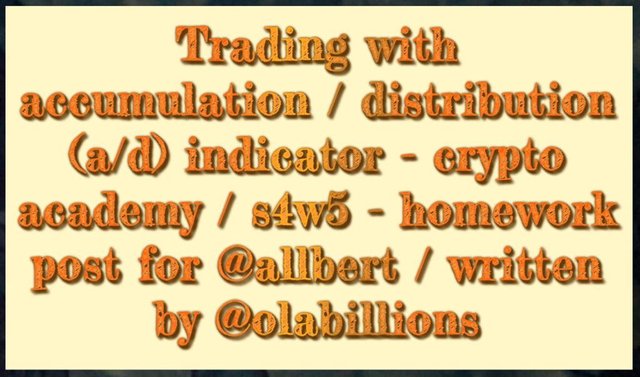
Explain in your own words what the A/D Indicator is and how and why it relates to volume. (Screenshots needed).
For some of us, it is not new that the cryptocurrency market are controlled by individual sentiment or reaction towards a certain coin, so as there are other indicators that indicates traders about who is in control of the market, we have the A/D indicator, which also indicate level of demand and supply.
The A/D indicator is an indicator that indicate the buy/sell control of asset in the market, the A/D indicator is an acronym of Accumulation and Distribution indicator,it can also be called the A/D line.
When buyers are in control, the indicator indicate accumulation which shows a rise in the price of the asset and rise in indicator, conversely when the sellers are in control it indicates distribution whereby the asset is being distributed, causing the price of the asset to go down and also indicating a downward movement in the indicator.
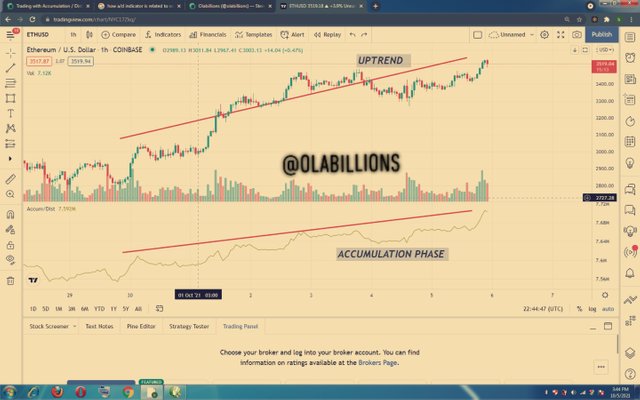
The A/D indicator indicate the flow of money in a particular asset. so as the name implies, the [A] which stands for Accumulation denote the demand of an asset or the level of buying.
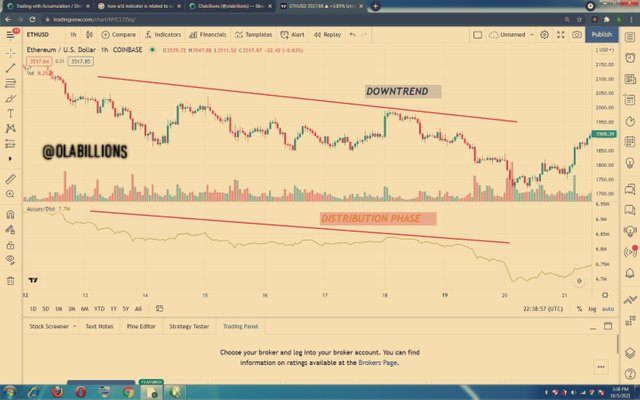
while the [D] which stands for Distribution indicate the level of selling, it denotes supply of an asset. So based on the law of supply and demand pressure of an asset, one can indicate or predict the assets future price trend.
It is used to determine or predict the direction of volume flow of an asset, it is a volume-based indicator using the connection between flow of volume and asset price to determine the trend of the asset. So, using the A/D indicator to know the future trend or asset price, it requires measuring the A/D rate therefore indicating the position of the trend in the current market or signifies a new trend or end of a trend or rather it could be telling us the end of a phase(either A/D) which is about pave way for another phase (either A/D).
I said earlier the A/D indicator is a volume-based indicator, the liquidity in the market is indicated by volume as such the A/D indicator measures the liquidity formed in the assets which indicates the pressure in control of the market, with this we can get a relationship between the A/D indicator and the volume because if we are in a distribution phase the asset is very much being sold which denotes the volume of liquidity to be reducing because of the selling pressure causing the price to go low.
Through some platforms, show the process of how to place the A/D Indicator (Screenshots needed).
I'll be demonstrating how to add the ad indicator on a chat with the use of trading views platform
Log into the platform website trading view
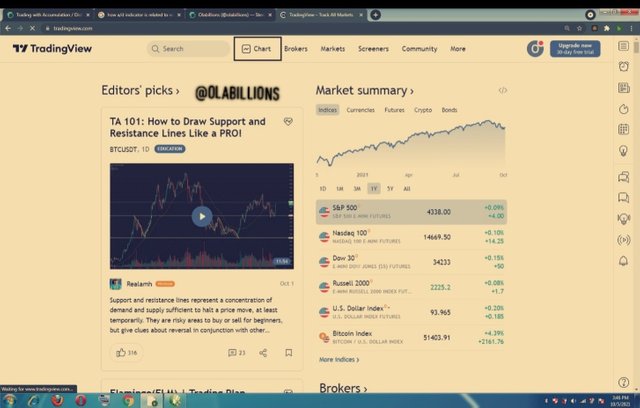
Click on the chart
Select the crypto pair you intend to use the indicator on.
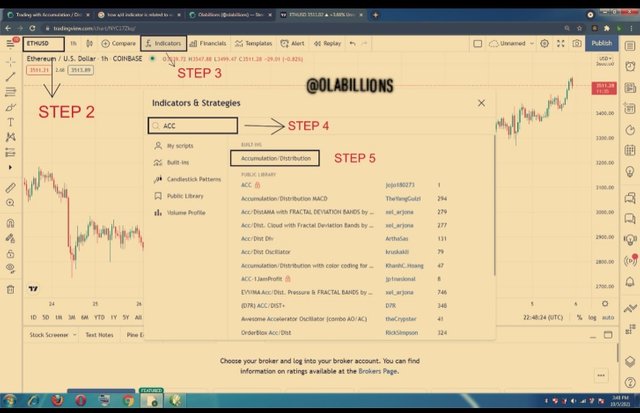
Click on the FX symbol (indicator) at the top panel of the chart interface.
In the search page search for accumulation .
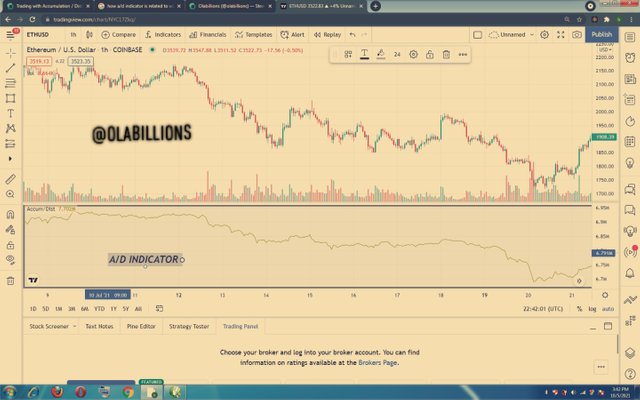
- Click on the first option that appears from the search engine then it automatically adds to the chart below the candles as seen in the screenshot.
Explain through an example the formula of the A/D Indicator. (Originality will be taken into account).
To calculate the A/D indicator, the follow steps should be followed.
We start by calculating the money flow multiplier.
To calculate money flow multiplier, it requires the subtraction of the closing price of a period and the low price of the day minus the high price of the day from the close price of a period divided by the high and low of the day.
Mathematically, the formula goes thus:-
Money flow multiplier (MFM) = (close - low) - (high - close)/(high - low)
Then, the money flow volume will be calculated,
To do this, it requires the multiplication of the money flow multiplier and the period volume.
Mathematically the formula goes thus:-
Money flow volume(MFV) = MFM x period volume
And lastly the A/D value can then be gotten by adding the period A/D and the money flow volume.
The formula goes thus:-
The A/D value = period volume + MFV
After understanding the formula, let take this screenshot for example.
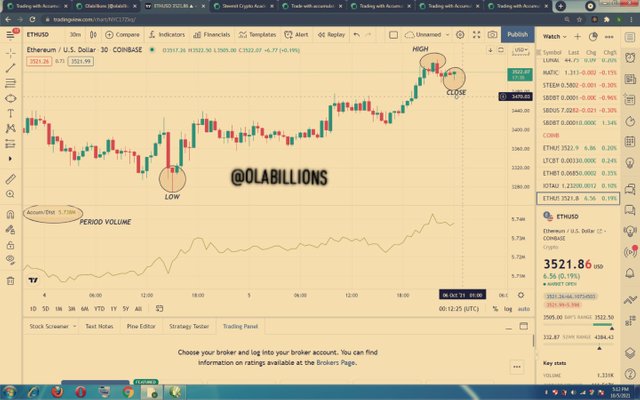
The screenshot above denote that the close, low, high and period volume.
Low:- 3270.06
High:- 3547.55
Close:- 3522.07
Period volume:- 5.768m
MFM= (close price - low price) - (high price - close price )/(high price - low price)
(3522.07 - 3270.06) - (3547.55 - 3522.07)/(3547.55 - 3270.06)
(252.01 - 25.48)/(277.49)
(226.53)/(277.49)
MONEY FLOW MULTIPLIER = 0.816
then,
MFV = MFM x Period volume
0.816 x 5.738m
MFV = 4.682
The A/D value = MFV + Period volume
4.682 + 5.738m
the A/D value = 10.417m
How is it possible to detect and confirm a trend through the A/D indicator? (Screenshots needed)
The A/D indicator is reliable as it confirms trend of an asset, if the A/D indicator and the asset price both make high peak and high trough, the trend seen is upward which indicate accumulation, the uptrend is a strong one because the asset price and the indicator both make an upward movement, which mean that the buying pressure is high and money is flowing in the asset which result in rise of the asset price and the indicator.

In the screenshot above, the phase seen here is the accumulation phase, which was formed as a result of money flow in the asset whereby buyer or trader are intending holding the asset in question for a long period. Here we can see the upward movement in the candle and the significant rise of the indicator seen in the screenshot, the rise of both asset price and indicator confirms that the trend seen is a strong bullish trend.
The indicator also confirms if the money is flowing out of the asset which we know as distribution, here trader are selling their asset as such, the selling pressure supersedes the buying pressure, the asset price begins to go low and to confirm if the downtrend seen is a strong one, the indicator too must have headed downward, when this is seen, It represents a strong downtrend confirmation that the asset is heading to a distribution phase.

The screenshot denote a distribution phase whereby money is flowing out of the asset which result in the decrease of the asset price and the significant decrease of the indicator confirms the trend is in a distribution phase, as this is seen It represents a strong selling pressure
Through a DEMO account, perform one trading operation (BUY or SELL) using the A/D Indicator only. (Screenshots needed)
In the trading view platform, the trade operation will be carried out and the pair used for this trade Is XRP/USDT.
In a 30 minutes time frame I found the XRP/USDT pair trading in operation.
In the chart I found a divergence whereby the indicator is signifying a downtrend movement and asset price say otherwise moving upward as such money is flowing out of the asset thereby a reversal is expected.
I then drew a trend line on the several higher low formed in the chart pattern.
I waited for the price to break the trend line downward because money keeps flowing out.
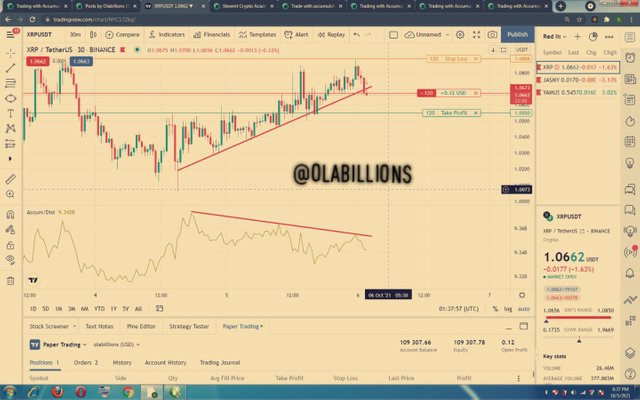
As soon as it breaks the trend line, I made my entry on the next candle after the price broke the trend line.
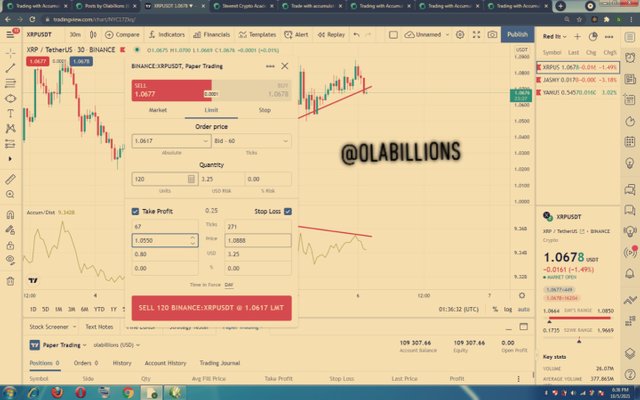
Then I placed my take profit, which could be 1:1, 1:2 or 1:3 risk/rewards ratio.
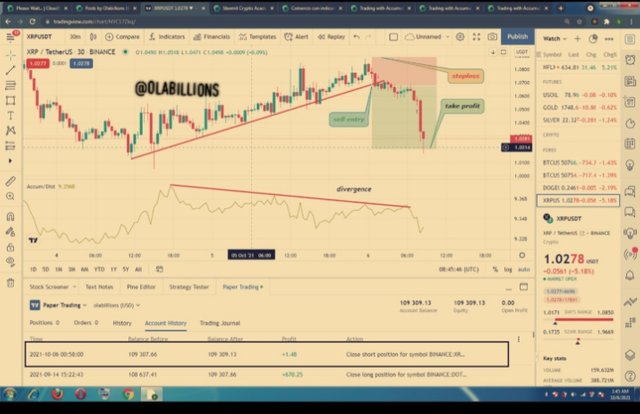
At the top recent highest price of the recent bullish candle, I set my stop loss, which is a little bit above the bullish wick.
After some hours the take profit was triggered and a profit of +1.48 was made from the trade.
What other indicator can be used in conjunction with the A/D Indicator. Justify, explain and test. (Screenshots needed).
As a trader we should avoid using an indicator as a stand alone tool, A/D indicator is not left out, as it sometimes render false signals. It is advisable to combine ADL with other indicators that will cover aspect where by the indicator come short of, like measuring other aspect of price action.
The relative strength index (RSI) is a momentum oscillator that will only add value to the A/D indicator, when added accordingly, as such it will measure the price action in magnitude and velocity.
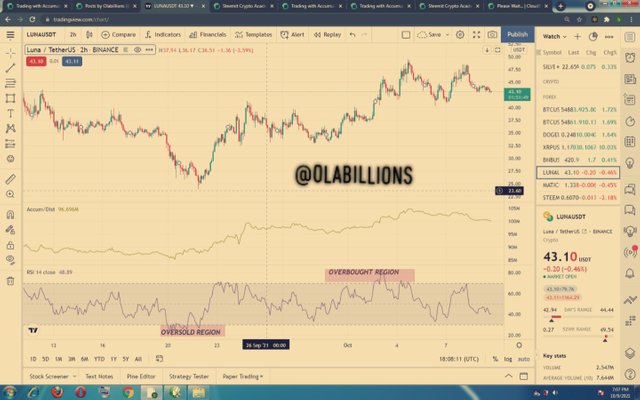
The RSI uses a default period of 14 days time frame, it indicate when an asset is oversold or overbought. It has a scale it uses in measuring from 0 - 100. The 30 marks and 70 mark are important level of indication where by the 70 marks the high level and the 30 marks the low level.
The RSI indicator signals an oversold asset, when the RSI measures below 30 - 0, which mean the selling pressure is higher than the buying pressure, advantages are taken at this level by traders as they begin to buy the asset at a low price which will lead to a bullish reversal as a result of the accumulation of asset.
Inversely, The overbought region marks from 70 above, in this level the price of an asset is already at its peak as a result of buying pressure, It is then followed by a bearish reversal because at this level traders distribute their asset at the high price in order to make profits.
The RSI is much more sensitive when indicating these levels unlike the A/D indicator that just follow price movement, in combination with this oscillating indicator, The A/D tool will not lose its value or rather it will add to its value and helps in determining the period of buy and sell of an asset.

In the screenshot above, an uptrend was seen as a result of rising price movement and the A/D indicator moving in the direction of the trend as such this is a strong bullish signal as the RSI confirms the trend that it is in an overpriced zone of which a reversal is expected at any point in time.
I get I were to test this indicators as asked by the prof but I don't have much time on my side as the deadline to submit the excessive is in few a minute
Conclusion
The A/D indicator denote divergence which is a plus to the A/D indicator of which it uses the bullish and bearish divergence to make entry of both buy and sell.
The identification of a bullish divergence is spotted when the price indicates a downward movement forming several lower low and the A/D indicator moving in an opposite way indicating an upward movement and forming several higher lows. this divergence denote bullish movement and traders should be alert for a long buying opportunity in their trading position.
The divergence also occur in bearish way, whereby the price will be rising, forming several higher highs of which the indicator is moving downward indicating several lower highs. This signifies a sell signal as money is flowing out of the asset.
It is easy to confirm a trend using AD indicator in a bullish trend, the price must be rising and the indicator also must be rising. If this is seen, it's a confirmation of a sting bullish phase of the asset and vise versa.

